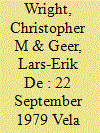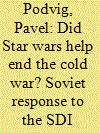|
|
|
Sort Order |
|
|
|
Items / Page
|
|
|
|
|
|
|
| Srl | Item |
| 1 |
ID:
157473


|
|
|
|
|
| Summary/Abstract |
On 22 September 1979 two optical sensors on U.S. satellite Vela 6911 detected a double-flash of light that appeared characteristic of an atmospheric nuclear explosion conducted over the southern Atlantic or Indian Ocean. It became known as the Vela Incident, Event 747, or Alert 747. An anomaly between the amplitude of the two signals during the second pulse led a U.S. government expert panel established to assess the event to conclude in mid-1980 that a more likely explanation was the impact of a small meteoroid on the satellite, the debris from which reflected sunlight into the sensors' field of view. No model was presented to support the contention, and a similar anomaly--known as background modulation--was a given for the second pulse of all confirmed explosions detected by Vela, though beginning later. Nonetheless, this event has remained the subject of intense debate. This article reviews the evidence and presents an updated analysis of the original Vela signal based on recently declassified literature and on modern knowledge of interplanetary dust and hyper velocity impact. Given the geometry of the satellite, and that the bulk of the surface comprised solar panels, much of the debris from any collision would be carried away from the sensors' field of view. Thus, a meteoroid collision appears much less likely than previously assumed. The double flash is instead consistent with a nuclear explosion, albeit detected by an aged satellite for which background modulation was abnormal and/or commenced earlier, also seen in post-event system tests. A companion paper to be published in 2018 presents radionuclide and hydroacoustic evidence supporting the conclusion that the Vela Incident was a nuclear weapon test explosion.
|
|
|
|
|
|
|
|
|
|
|
|
|
|
|
|
| 2 |
ID:
157470


|
|
|
|
|
| Summary/Abstract |
Proponents of high temperature gas cooled reactors argue that the reactor type is inherently safe and that severe accidents with core damage and radioactive releases cannot occur. The argument is primarily based on the safety features of the special form of the fuel. This paper examines some of the assumptions underlying the safety case for high temperature gas cooled reactors and highlights ways in which there could be fuel failure even during normal operations of the reactor; these failures serve to create a radioactive inventory that could be released under accident conditions. It then describes the severe accident scenarios that are the greatest challenge to high temperature gas cooled reactor safety: ingress of air or water into the core. Then, the paper offers an overview of what could be learned from the experiences with high temperature gas cooled reactors that have been built; their operating history indicates differences between actual operations and theoretical behavior. Finally, the paper describes some of the multiple priorities that often drive reactor design, and how safety is compromised in the process of optimizing other priorities.
|
|
|
|
|
|
|
|
|
|
|
|
|
|
|
|
| 3 |
ID:
157468


|
|
|
|
|
| Summary/Abstract |
The Strategic Defense Initiative was a U.S. missile defense program that played a very prominent role in the U.S.-Soviet relationships in the 1980s and is often credited with helping end the Cold War, as it presented the Soviet Union with a technological challenge that it could not meet. This article introduces several official Soviet documents to examine Soviet response to SDI. The evidence suggests that although the Soviet Union expressed serious concerns about U.S. missile defense program, SDI was not a decisive factor in advancing arms control negotiations. Instead, the program seriously complicated U.S.-Soviet arms control process. SDI also failed to dissuade the Soviet Union from investing in development of ballistic missiles. The Soviet Union quickly identified ways to avoid a technological arms race with the United States and focused on development of advanced missiles and anti-satellite systems to counter missile defenses. Some of these programs have been preserved to the current day.
|
|
|
|
|
|
|
|
|
|
|
|
|
|
|
|
| 4 |
ID:
157471


|
|
|
|
|
| Summary/Abstract |
In 2013, the staff of the U.S. Nuclear Regulatory Commission estimated the reduction of the off-site economic losses from a fire in a drained U.S. spent fuel pool if fuel that had cooled for more than five years were transferred to dry cask storage--an option it called "expedited transfer." In this article, it is shown that the savings would be much higher than the NRC estimated. Savings increase to about $2 trillion if: losses beyond 50 miles are included; the land-contamination threshold for long-term population relocation is changed to that used for the Chernobyl and Fukushima accidents and recommended by the U.S. Environmental Protection Agency; and, based on the experience of Japan, decontamination of land areas to levels acceptable for population return is assumed to take at least four years. If expedited transfer were implemented, the off-site economic losses would be reduced by about 98%.
|
|
|
|
|
|
|
|
|
|
|
|
|
|
|
|
| 5 |
ID:
157474


|
|
|
|
|
| Summary/Abstract |
Terrorists could acquire nuclear weapons by using weapon-usable nuclear material that was stolen or otherwise diverted from legitimate authorities. Multiple well-documented seizures suggest the existence of a black market that draws on an unknown stock of weapon-usable nuclear material that is not under the control of authorities. We estimate the total amount of uncontrolled material based on publicly reported seizures and several different statistical methods and models. We estimate that 90 to 250 kilograms--sufficient for up to ten nuclear weapons--remain outside the control of legitimate authorities. While this estimate is subject to large uncertainties and potential bias, governments may have additional information about nuclear material seizures that could be used to improve estimates.
|
|
|
|
|
|
|
|
|
|
|
|
|
|
|
|
| 6 |
ID:
157469


|
|
|
|
|
| Summary/Abstract |
Peace and global security are human endeavors, and thus their attainment depends as much on psychology as it does on governance and technology. In this paper I outline 3 ways our evolved psychology is an obstacle to achieving international cooperation and peace. First, humans show strong evidence of adaptations for cooperation within groups, but equally clear evidence that this cooperative nature does not extend to members of other groups. Second, humans evolved to have a relative sense of fairness, and thus will often reject even mutually beneficial agreements if they benefit others more than themselves. Third, humans evolved to be self-deceptive and hypocritical, believing in the unique righteousness and inevitable victory of their own cause, which tends to exacerbate conflict. Nevertheless, these obstacles are not insurmountable and an awareness of them can help in the development of strategies to increase the chances of lasting peace and security.
|
|
|
|
|
|
|
|
|
|
|
|
|
|
|
|
| 7 |
ID:
157475


|
|
|
|
|
| Summary/Abstract |
Phosphate rocks are predominantly mined for fertilizer production. However, they also contain considerable amounts of accompanying natural uranium that can exceed concentrations found at commercial uranium mines. Extracting uranium from phosphate rocks during fertilizer production is a technically mature process; it was used on an industrial scale in the United States and elsewhere before decreasing uranium prices made this practice unprofitable in the 1990s. Soon, technical improvements, potentially rising uranium prices, and anticipated environmental regulations may make uranium extraction from phosphates profitable again in the United States and emerging phosphate rock mining centers in Northern Africa and the Middle East. Extracting uranium during phosphate fertilizer production is desirable in a way that otherwise lost resources are conserved and fertilizers with reduced radiotoxic heavy metal content are produced. Phosphate rocks have also been subject to clandestine uranium acquisition. In this work, the relevance of unconventional uranium resources from phosphate rocks is reviewed. A brief overview of the extraction process, a list of the required materials, and a very simple estimation of the amounts of uranium that could be extracted using a container-sized pilot plant which can be integrated into existing fertilizer plants is provided. Lastly, past known unreported uranium extraction activities from phosphate rocks are discussed.
|
|
|
|
|
|
|
|
|
|
|
|
|
|
|
|
| 8 |
ID:
157472


|
|
|
|
|
| Summary/Abstract |
This article examines challenges in international nuclear safeguards pertaining to the timely detection of highly enriched uranium production at large-scale gas centrifuge enrichment plants. To establish where present gas centrifuge enrichment plant safeguards measures and approaches could be strengthened, we have created a discrete time model for simulating hypothetical misuse scenarios, both through transient phases and at steady-state. We find that timely detection of misuse at modern large-scale facilities presents a challenge for international safeguards. A toolbox of unattended measurement systems, along with remote monitoring, however, could be used to improve detection timeliness, enabling the initiation of follow-up activities, potentially on a rapid time scale. These measures, which would need very low false alarm rates, should be implemented in a graded approach, depending on the characteristics of each enrichment plant and an analysis of plausible acquisition paths for the State in which it is situated. Some of these technologies could provide significant benefit to plant operators.
|
|
|
|
|
|
|
|
|
|
|
|
|
|
|
|
|
|
|
|
|